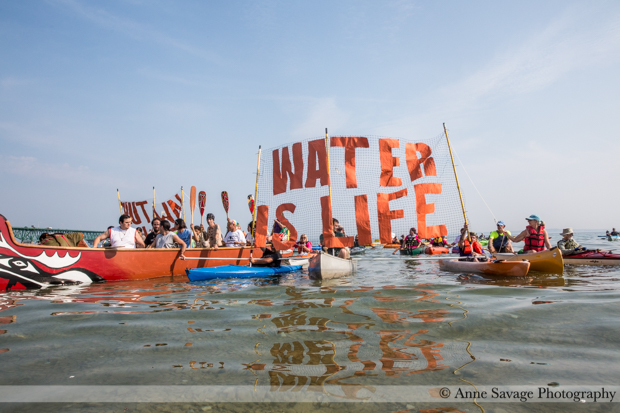
We’ve been writing about Line 5, Enbridge’s 67-year-old twin pipelines under the straights of Mackinac for 5 years now:
- June 23, 2015 — Enbridge Line 5 pipeline beneath Straits of Mackinac – too old, unsafe, and a threat to the Great Lakes
- September 10, 2015 — As protesters call for Straits of Mackinac oil pipeline to be shut down, Enbridge promises NOT to do something it’s NEVER done
- January 26, 2016 — Bill to shield oil & gas companies from FOIA requests advances in Michigan legislature, now in a more friendly committee
- March 4, 2016 — Shutting down Line 5 oil pipeline under the Straits of Mackinac unites MI-01 candidate Lon Johnson with GOP mayor
- July 16, 2016 — What Snyder’s choice of an oil executive as DEQ director says to Michiganders
- August 19, 2017 — It’s time for Michigan Attorney General Schuette to shut down Enbridge Line 5 running under the Straits of Mackinac NOW
- Aprill 12, 2018 — After environmental catastrophe near-miss with Enbridge’s Line 5 pipeline under Lake Michigan, Gov. Snyder issues sternly-worded press release
- April 4, 2019 — GOP House Speaker Chatfield’s comment that AG Nessel and Gov. Whitmer are “driven purely by emotion” is TOTALLY NOT SEXIST AT ALL, says Chatfield
- June 12, 2019 — Big Oil AstroTurf group comes to the rescue of Enbridge Energy and its ticking time bomb, the 66-year old Line 5 pipeline
Here are some of the ways we’ve described the pipeline during that time:
- “Old and out-of-date”
- “Decrepit”
- “Notorious”
- “Controversial”
- “Dangerous”
- “Ticking time bomb”
Here’s how we’ve described the oil spill that will eventually happen if this pair of old, out-of-date, decrepit, notorious, controversial, dangerous ticking time bombs aren’t shut down promptly:
- “Could spew toxins into the largest grouping of freshwater lakes in the world, and the source of drinking water for over 35 million people”
- “Devastating and widespread — not to mention long-lasting — ramifications beyond our wildest comprehension”
- “Utter catastrophe”
- “Shudder-inducing”
- “The stuff of Michiganders’ nightmares”
- “Catastrophic”
- “An unimaginable environmental catastrophe”
- “Would take nearly $2 billion to clean up and would despoil some of the most beautiful coastline in the USA”
Two years ago, we narrowly avoided this catastrophe after a tugboat unknowingly dragged it’s anchor across the pipelines, causing extensive damage.
This week we learned that a second near-miss in just two years occurred. Here’s the backstory from Bridge:
In mid-September, workers for Enbridge Inc. dug deep, narrow holes to gather rock and soil samples along the lakebed under the Straits of Mackinac as a part of the project to build a tunnel to protect the Line 5 oil pipeline.
One of those holes collapsed, leaving 40 feet of thin drilling rod lodged in the ground and another 45 feet of broken rod on the lake bottom, 245 feet below the water’s surface, according to a letter the state sent to Enbridge Tuesday notifying them of the violation. They waited until the sampling work was done two months later before reporting it to the state.
Now it’s too late in the year for the company to safely retrieve the debris, which a spokesman says the company will collect in spring when the weather is safer for such a deep dive.
Ryan Duffy, spokesman for Enbridge, told Bridge the 3-inch-wide rods don’t pose a safety or environmental risk in the meantime. The two-month reporting delay was necessary, he said, so the company could do a thorough risk assessment at such great depths.
It’s clear that Duffy’s explanation for the two-month delay is a steaming pile of bovine fecal matter. And what is now equally — and quite painfully — clear is that his claim that the rods don’t pose a safety or environmental risk is a similar steaming pile, thanks to the Whitmer administration compelling Enbridge to retrieve the rods before spring:
Enbridge Energy has retrieved a 45-foot steel rod it left in the Straits of Mackinac in September. Strong currents moved the rod 150 feet during its time underwater. […]
Joseph Haas of the Michigan Department of Environment, Great Lakes and Energy says he thinks both the state and Enbridge were surprised by how the currents had moved the rod.
“We just didn’t see it as a real urgency that it get out of there in an instantaneous or super-urgent manner,” he says. “In hindsight, they reported upon removal that that rod had migrated 150 feet and was leaning against the west leg of the pipeline. I don’t think anybody expected that such a low-profile, heavy, probably 250 pound piece of steel would have migrated 150 feet.”
Enbridge technically violated the Great Lakes Submerged Lands Act by dropping debris in that location, but Haas says it’s not the kind of thing his agency would normally impose a fine for. It was an accident and no infrastructure was impacted.
He does, however, call it a “lesson learned.”
“Wow, that pipe moved 150 feet since Sept. 12,” says Haas. “That’s a pretty big deal. We need to be paying close attention to things in the straits.”
Despite the fact that the strong currents had moved a 250-pound chunk of spear-shaped steel 150 feet where it ended up resting against one of the pipelines, Enbridge still laughably claims “never posed any safety or environmental risk to Line 5.” The fact that both regulators in the state government and Enbridge themselves are still “learning lessons” about the power of the Straits of Mackinac and the extreme vulnerability of their retirement-aged twin pipelines just proves that this oil and gas giant is out of its league and should NOT be risking the Great Lakes with their lust for profits. And they certainly shouldn’t be drilling a tunnel under the Straits to make these pipelines all but permanent, the course that they embarked upon just before Republican Governor Rick Snyder left office (and with his blessing, of course.)
Keep in mind that, despite Big Oil and Gas lobbyists’ claims that this is vital infrastucture, it’s not. Running the pipeline through our state and under the Straits of Mackinac is simply a shortcut:

Image courtesy of For Love of Water (FLOW)
It’s important for citizens to stay vigilant on this issue and contact the offices of the Michigan Governor and the Attorney General. You can contact Governor Whitmer HERE and by sending an email to AG Nessel at miag@michigan.gov.
I’ll close with this from the Traverse City Record-Eagle‘s scorching op-ed “Mother Nature is sending a message on Line 5”:
We probably shouldn’t be surprised at the overwhelming power of the Great Lakes, especially in an area where currents are notoriously strong. Such clear evidence also lends credence to an independent technical report authored in 2017 by retired Dow Chemical engineer Ed Timm. In his analysis, Timm supposed that bends in the twin Line 5 pipes, and long unsupported spans could be attributed to the force of strong currents that sweep through the lakebed where it pinches between the peninsulas.
Timm’s assertions triggered nods of agreement from just about anybody grounded in common sense, but were challenged by Enbridge officials.
In hindsight, it’s pretty clear Timm was onto something.
Worse, last week’s surprise is an alarming underestimation by the people in charge of overseeing the safety and integrity of an oil pipeline that flows 23 million gallons of oil and natural gas liquids through our lakes each day.
Hindsight is not a view we find acceptable when it comes to a potential oil disaster in the lakes that provide for so many of us.
We have long urged state regulators, the governor included, to set a date by which oil must stop flowing through the retirement-age pipes situated on our lakebed. So far, they have failed to heed our advice, our pleas to make moves that will head off catastrophe.
Maybe this time they will listen to their mother.



